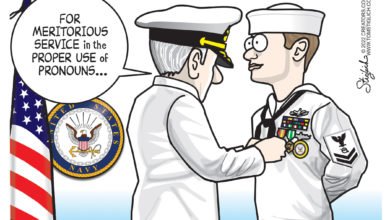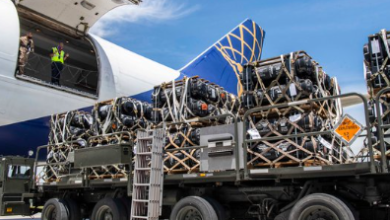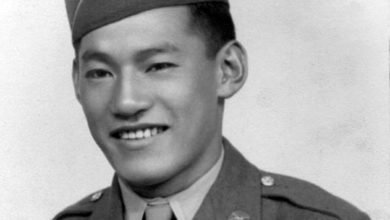Marine Corps Cpl. Hershel Williams
The Battle of Iwo Jima in the Pacific during World War II is one of the most famous battles of all time. A photo of service members raising the American flag there on Feb. 23, 1945, is iconic, and it was the inspiration behind the Marine Corps War Memorial near Arlington National Cemetery.
Also iconic is Hershel “Woody” Williams, a Marine who is the last surviving Medal of Honor recipient to have fought in that battle. He wasn’t part of the flag-raising, but his actions were crucial to an American victory.
Thrown Into the Mix
Williams joined the Marines in May 1943 and was shipped off to the Pacific Theater three months later. The dairy farmer from Quiet Dell, West Virginia, was trained to be a demolition sergeant, which meant he knew how to use flamethrowers and detonate explosives. He took part in the battle to retake Guam in the summer of 1944 before being sent to Iwo Jima, a tiny island in the Volcano Islands chain. The two were vastly different.
”Guam was more jungle-type fighting — a lot of creeping and crawling — but when we got to Iwo Jima, everything had been wiped off that island,” Williams explained in a Veterans History Project Library of Congress interview. ”About the only protection you could find would be a shell crater, or try to dig your own hole.”
The Battle Begins
The Battle of Iwo Jima began Feb. 19, 1945. Winning there was crucial, because the U.S. needed the island’s airfields. Other U.S.-occupied islands were too far away for fighter jets to be able to escort bomber missions to Japan’s mainland.
Williams’ reserve unit was sent ashore two days after the battle started, and the scene was chaotic. He said they found out quickly that the land was incredibly difficult to maneuver.
“Trying to dig a hole in that stuff was like trying to dig a hole in marbles,” Williams explained of the volcanic black sand. “Trying to run on it was almost impossible. You couldn’t get a foothold.”
It was also incredibly hot.
“You could take a C-ration can of food and dig a hole and bury it, and the next morning, you could have hot food,” he said.
The tanks had trouble opening up a lane for the infantry through the sand, too, but the biggest problem was the many steel-reinforced “pillboxes,” now known as bunkers, that were protecting the Japanese airfields.
“Bazookas and that sort of thing had no effect on them, because they were so thick and well built,” Williams said in a 2017 interview. “The only way to actually eliminate the enemy inside those pillboxes was by flamethrower.”
Just Doing His Job
Marines were dropping like flies during the battle. Williams had initially been one of several demolition sergeants, but by Feb. 23, 1945, he was the only one left. So, he bravely volunteered to go forward as the last flamethrower to try to quell the devastating machine-gun fire from the pillboxes.
In four hours, with only four riflemen to protect him, Williams managed to wipe out seven pillboxes. He repeatedly prepared explosives in a safe area, struggled back to where the enemy was, and then set the charges off.
One time, he jumped onto one of the pillboxes from the side, shoved the nozzle of his 70-pound flamethrower into an air vent pipe and fired, killing everyone inside. Another time, he charged bayonet-wielding enemies and killed them with one burst of flame.
“That made a hole big enough that [the company] could go through and get behind any other pillboxes that were in that area,” Williams said. “Once you got behind the pillboxes, then we had the advantage.”
An Honor For All
Williams’ efforts massively helped to neutralize one of the most fanatically defended Japanese strongholds his regiment had encountered. For his actions, he received the Medal of Honor from President Harry S. Truman during a group ceremony at the White House on Oct. 5, 1945. Ten other Marines and two sailors also received the honor that day.
Williams was discharged in 1945, but he stayed in the Marine Corps Reserve until his retirement. Nowadays, he continues to serve through his foundation, the Hershel Woody Williams Medal of Honor Foundation, which honors families who have lost a loved one in service to their country.
Williams said it’s those men — the ones who died protecting him — who really deserve the honor.
“This medal doesn’t belong to me. It belongs to them, because they gave their lives for me,” he said, trying to hold back tears. “I was just doing a job that I was trained to do.”
However, Williams — who turned 95 in October — continues to be honored. The USNS Hershel “Woody” Williams, an expeditionary sea base ship, completed its maiden voyage in July.
This article is part of a weekly series called “Medal of Honor Monday,” in which we highlight one of the more than 3,500 Medal of Honor recipients who have earned the U.S. military’s highest medal for valor.
Source: Department of Defense
Content created by Conservative Daily News is available for re-publication without charge under the Creative Commons license. Visit our syndication page for details.




